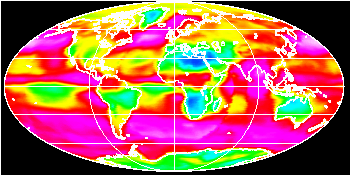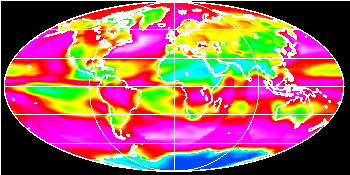Condensation or deposition of water above the Earth's surface creates clouds. In general, clouds develop in any air mass that becomes saturated (relative humidity becomes 100%). Saturation can occur by way of atmospheric mechanisms that cause the temperature of an air mass to be cooled to its dew point or frost point. The following mechanisms or processes can achieve this outcome causing clouds to develop:
(1). Orographic uplift occurs when air is forced to rise because of the physical presence of elevated land. As the parcel rises it cools as a result of adiabatic expansion at a rate of approximately 10° Celsius per 1000 meters until saturation. The development of clouds and resulting heavy quantities of precipitation along the west coast of Canada are mainly due to this process.
(2). Convectional lifting is associated with surface heating of the air at the ground surface. If enough heating occurs, the mass of air becomes warmer and lighter than the air in the surrounding environment, and just like a hot air balloon it begins to rise, expand, and cool. When sufficient cooling has taken place saturation occurs forming clouds. This process is active in the interior of continents and near the equator forming cumulus clouds and or cumulonimbus clouds (thunderstorms). The rain that is associated with the development of thunderstorm clouds is delivered in large amounts over short periods of time in extremely localized areas.
(3). Convergence or frontal lifting takes place when two masses of air come together. In most cases, the two air masses have different temperature and moisture characteristics. Oneof the air masses is usually warm and moist, while the other is cold and dry. The leading edge of the latter air mass acts as an inclined wall or front causing the moist warm air to be lifted. Of course the lifting causes the warm moist air mass to cool due to expansion resulting in saturation. This cloud formation mechanism is common at the mid-latitudes where cyclones form along the polar front and near the equator where the trade winds meet at the intertropical convergence zone.
(4). Radiative cooling occurs when the Sun is no longer supplying the ground and overlying air with energy derived from solar insolation (e.g., night). Instead, the surface of the Earth now begins to lose energy in the form of longwave radiation which causes the ground and air above it to cool. The clouds that result from this type of cooling take the form of surface fog.
Of course these causes of cloud development do not always act in a singular fashion. It is possible to get combinations of all four types, such as when convection and orographic uplift cause summer afternoon cloud development and showers in the mountains.
The following two images (Figures 8e-1 and 8e-2)
describe percent global cloud coverage averaged for the
months of July and January using 8 years of data. From
these images one can see the effects of convergence, frontal
lifting, and orographic
uplift in enhancing cloud cover over select areas
of the Earth.

| Figure 8e-1: Percent cloud cover: July 1983-1990. Highest levels of cloud cover occur over the mid-latitude cyclone storm tracks of both hemispheres, Intertropical Convergence Zone over land surfaces, and the Indian Monsoon region (orographic lifting). Lowest values occur over the subtropical deserts, the subsidence regions of the subtropical oceans, and the polar regions. Color range: blue - red - white, Values: 0 - 100%. Global mean = 59%, Minimum = 1%, Maximum = 95%. (Source: NASA Surface Radiation Budget Project). |

| Figure 8e-2: Percent cloud cover: January 1984-1991. Highest levels of cloud cover occur over the mid-latitude cyclone storm tracks of both hemispheres and the Intertropical Convergence Zone over land surfaces. Lowest values occur over the subtropical deserts, the subsidence regions of the subtropical oceans, and over the South Pole. Color range: blue - red - white, Values: 0 - 100%. Global mean = 59%, Minimum = 1%, Maximum = 96%. (Source: NASA Surface Radiation Budget Project). |